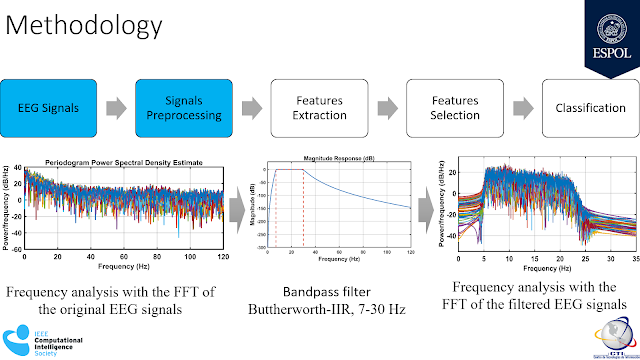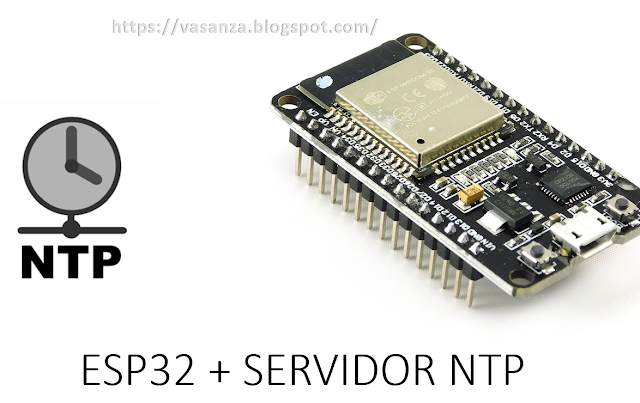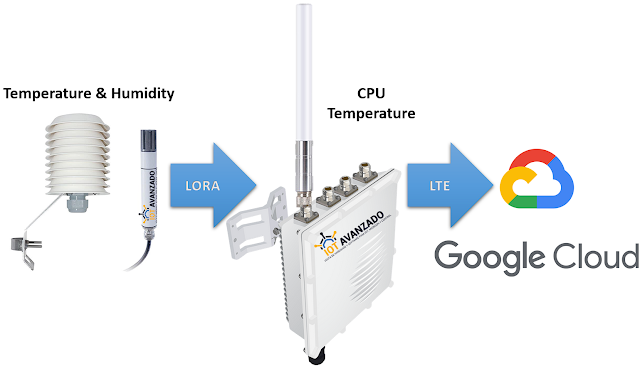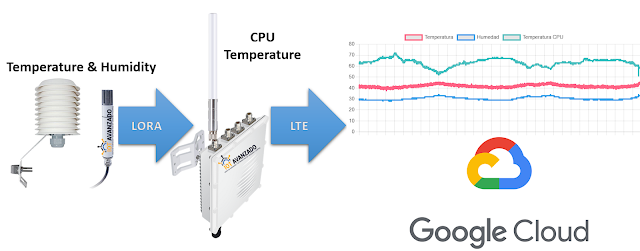▷ Supervised Pattern Recognition Techniques for Detecting Motor Intention of Lower Limbs in Subjects with Cerebral Palsy
⭐⭐⭐⭐⭐ Supervised Pattern Recognition Techniques for Detecting Motor Intention of Lower Limbs in Subjects with Cerebral Palsy from Victor Asanza Armijos
- ➡️ #EEG #Classification #HumanMachineInterface #BCI #BrainComputerInterface
- ➡️ ETCM: IEEE Ecuador Technical Chapters Meeting (ETCM2017)
- ⭐ Read full paper: https://ieeexplore.ieee.org/abstract/document/8247452
- ✅ Read Proceedings: https://ieeexplore.ieee.org/xpl/conhome/8232983/proceeding
- When using this resource, please cite the original publication:
- Abstract:
- Cerebral Palsy (CP) is one of the major conditions that prevent subjects suffering from having free control over their limbs, currently the use of electroencephalography (EEG) signals to control rehabilitation devices is a very useful alternative. However, these EEG signals are susceptible to noise and a filtering preprocessing is necessary before the feature extraction and classification. There are very good algorithms detecting motor intensities in the upper limbs such as Least Squares Support Vector Machine (LS-SVM) with spectral density characteristics. However, in the present work we propose to determine the algorithms of extraction of characteristics and classification that allow to detect satisfactorily the motor intensities in lower limbs.
- ✅ References:
- M. P. Arias Armijos, Características epidemiológicas y clinícas de la parálisis cerebral en el servicio de Hospitalización de Pediatriía del Hospital Vicente Corral Moscoso. Enero 2014-Junio 2015, 2016.
- N. Gómez-Regueira and S. Vinas-Diz, Mejora del control postural y equilibrio en la paràlisis cerebral infantil: revisi6ón sistemática. Fisioterapia, vol. 38, no. 4, pp. 196-214, 2016.
- L. F. G. Zapata and S. L. R. Mesa, "Alimentar y nutrir a un niño con parálisis cerebral. Una mirada desde las percepciones", Invest Educ Enferm [Internet], vol. 29, no. 1, pp. 28-39, 2011.
- J. Gomez-Pilar, R. Corralejo, L. F. Nicolas-Alonso, D. Alvarez and R. Hornero, "Neurofeedback training with a motor imagery-based BCI: neurocognitive improvements and EEG changes in the elderly", Medical & biological engineering & computing, pp. 1-12, 2016.
- J. Minguillon, M. A. Lopez-Gordo and F. Pelayo, "Trends in EEG-BCI for daily-life: Requirements for artifact removal", Biomedical Signal Processing and Control, vol. 31, pp. 407-418, 2017.
- C. Guger, A. Schlogl, C. Neuper, D. Walterspacher, T. Strein and G. Pfurtscheller, "Rapid prototyping of an EEG-based braincomputer interface (BCI)", IEEE Transactions on Neural Systems and Rehabilitation Engineering, vol. 9, no. 1, pp. 49-58, 2001.
- The Central Nervous System, [online] Available: http://classes.midlandstech.edu/carterp/Courses/bi0210/Chap12/lecture1.htm.
- Y. K. Shin, D. R. Lee, H. J. Hwang, S. J. H. You and C. H. Im, "A novel EEG-based brain mapping to determine cortical activation patterns in normal children and children with cerebral palsy during motor imagery tasks", NeuroRehabilitation, vol. 31, no. 4, pp. 349-355, 2012.
- G. R. Müller-Putz, R. Scherer, G. Pfurtscheller and R. Rupp, "EEG-based neuroprosthesis control: a step towards clinical practice", Neuroscience letters, vol. 382, no. 1, pp. 169-174, 2005.
- L. Gao, J. Wang and L. Chen, "Event-related desynchronization and synchronization quantification in motor-related EEG by Kolmogorov entropy", Journal of neural engineering, vol. 10, no. 3, 2013.
- J. J. Lee, D. R. Lee, Y. Kyum Shin, N. G. Lee, B. S. Han and S. J. H. You, "Comparative neuroimaging in children with cerebral palsy using tMRI and a novel EEG-based brain mapping during a motor task-a preliminary investigation", NeuroRehabilitation, vol. 32, no. 2, pp. 279-285, 2013.
- E. Kinney-Lang, B. Auyeung and J. Escudero, "Expanding the (kaleido) scope: exploring current literature trends for translating electroencephalography (EEG) based brain-computer interfaces for motor rehabilitation in children", Journal of Neural Engineering, vol. 13, no. 6, pp. 061002, 2016.
- N. Gómez-Regueira and S. Vinas-Diz, "Mejora del control postural y equilibrio en la parálisis cerebral infantil: revisión sistemática", Fisioterapia, vol. 38, no. 4, pp. 196-214, 2016.
- A. Agarwal and I. Verma, "Cerebral palsy in children: An overview", Journal of clinical orthopaedics and trauma, vol. 3, no. 2, pp. 77-81, 2012.
- A. M. Rosero Cobos, Influencia de las Actividades de Integración Sensorial en el Desarrollo Psicomotor en niños con Parálisis Cerebral de 2 a 6 años que asisten al instituto de Educación Especial del Carchi, 2014.
- M. P. Arias Armijos, "Características epidemiológicas y clínicas de la parálisis cerebral en el servicio de Hospitalización de Pediatría del Hospital Vicente Corral Moscoso", Enero 2014-Junio 2015, 2016.
- [online] Available: http://www.consejodiscapacidades.gob.ec/estadistica/index.html.
- M. V. Johnston, "Clinical disorders of brain plasticity", Brain and Development, vol. 26, no. 2, pp. 73-80, 2004.
- D. Boatman, J. Freeman, E. Vining, M. Pulsifer, D. Miglioretti, R. Minahan, et al., "Language recovery after left hemispherectomy in children with late-onset seizures", Annals of neurology, vol. 46, no. 4, pp. 579-586, 1999.
- A. K. Das, S. Suresh and N. Sundararajan, "A discriminative subject-specific spatio-spectral filter selection approach for EEG based motor-imagery task classification", Expert Systems with Applications, vol. 64, pp. 375-384, 2016.
- N. Mrachacz-Kersting, N. Jiang, A. J. T. Stevenson, I. K. Niazi, V. Kostic, A. Pavlovic, et al., "Efficient neuroplasticity induction in chronic stroke patients by an associative brain-computer interface", Journal of neurophysiology, vol. 115, no. 3, pp. 1410-1421, 2016.
- F. Pichiorri, F. D. V. Fallani, F. Cincotti, F. Babiloni, M. Molinari, S. C. Kleih, et al., "Sensorimotor rhythm-based braincomputer interface training: the impact on motor cortical responsiveness", Journal of neural engineering, vol. 8, no. 2, pp. 025020, 2011.
- B. M. Young, Z. Nigogosyan, L. M. Walton, J. Song, V. A. Nair, S. W. Grogan, et al., "Changes in functional brain organization and behavioral correlations after rehabilitative therapy using a brain-computer interface", Interaction of BCI with the underlying neurological conditions in patients: pros and cons, 2015.
- J. J. Daly and J. R. Wolpaw, Brain-computer interfaces in neurological rehabilitation. The Lancet Neurology, vol. 7, no. 11, pp. 1032-1043, 2008.
- M. Toledo-González, "Concepto. Etiología. Alto riesgo del recién naci-do. In Toledo González M ed. Parálisis cerebral", Madrid: Departa-mento de estudios y publicaciones del SEREM, pp. 25-45, 1977.
- A. Bringas-Grande, A. Fernández-Luque, C. García-Alfaro, M. Barrera-Chacon, M. Toledo-Gonzalez and J. M. Domínguez Roldan, "Parálisis cerebral infantil: estudio de 250 casos", Rev Neurol, vol. 35, no. 9, pp. 812-17, 2002.
- H. H. Jasper, "The ten twenty electrode system of the international federation", Electroencephalography and clinical neurophysiology, vol. 10, pp. 371-375, 1958.
- C. Guger, S. Daban, E. Sellers, C. Holzner, G. Krausz, R. Carabalona, et al., How many people are able to control a P300-based brain-computer interface (BCI)? Neuroscience letters, vol. 462, no. 1, pp. 94-98, 2009.
- K. K. Ang, K. S. G. Chua, K. S. Phua, C. Wang, Z. Y. Chin, C. W. K. Kuah, et al., "A randomized controlled trial of EEG-based motor imagery brain-computer interface robotic rehabilitation for stroke", Clinical EEG and neuroscience, vol. 1550059414522229, 2014.
- J. R. Wolpaw, "Brain-computer interfaces as new brain output pathways", The Journal of physiology, vol. 579, no. 3, pp. 613-619, 2007.
- B. Koo, H. G. Lee, Y. Nam, H. Kang, C. S. Koh, H. C. Shin, et al., "A hybrid NIRS-EEG system for self-paced brain computer interface with online motor imagery", Journal of neuroscience methods, vol. 244, pp. 26-32, 2015.
- C. S. L. Tsui, J. Q. Gan and S. J. Roberts, "A self-paced braincomputer interface for controlling a robot simulator: an online event labelling paradigm and an extended Kalman filter based algorithm for online training", Medical & biological engineering & computing, vol. 47, no. 3, pp. 257-265, 2009.
- M. S. Bascil, A. Y. Tesneli and F. Temurtas, "Spectral feature extraction of EEG signals and pattern recognition during mental tasks of 2-D cursor movements for BCI using SVM and ANN", Australasian physical & engineering sciences in medicine, vol. 39, no. 3, pp. 665-676, 2016.
- C. Ozgen, CLASSIFICATION OF MOTOR IMAGERY TASKS IN EEG SIGNAL AND ITS APPLICATION TO A BRAIN-COMPUTER INTERFACE FOR CONTROLLING ASSISTIVE ENVIRONMENTAL DEVICES, 2011.
- P. Stoica and R. L. Moses, Spectral Analysis of Signals, Upper Saddle River, NJ:Prentice Hall, 2005.
- Z. Gu, Z. Yu, Z. Shen and Y. Li, "An online semi-supervised brain-computer interface", IEEE Transactions on Biomedical Engineering, vol. 60, no. 9, pp. 2614-2623, 2013.
- E. Donchin, K. M. Spencer and R. Wijesinghe, "The mental prosthesis: assessing the speed of a P300-based brain-computer interface", IEEE transactions on rehabilitation engineering, vol. 8, no. 2, pp. 174-179, 2000.
- L. Zhang and C. Zheng, "Cortical lateralization analysis by kolmogorov entropy of EEG", Panhellenic Conference on Informatics, pp. 798-807, 2005, November.
- F. Lotte, L. Bougrain and M. Clerc, "Electroencephalography (EEG) □ Based Brain-Computer Interfaces", Wiley Encyclopedia of Electrical and Electronics Engineering, 2015.
- J. O. Lubar and J. F. Lubar, "Electroencephalographic biofeedback of SMR and beta for treatment of attention deficit disorders in a clinical setting", Biofeedback and self-regulation, vol. 9, no. 1, pp. 1-23, 1984.
- L. Gao, W. Cheng, J. Zhang and J. Wang, "EEG classification for motor imagery and resting state in BCI applications using multi-class Adaboost extreme learning machine", Review of Scientific Instruments, vol. 87, no. 8, 2016.
- R. Singla and B. A. Haseena, "Comparison of ssvep signal classification techniques using svm and ann models for bci applications", International Journal of Information and Electronics Engineering, vol. 4, no. 1, pp. 6, 2014.
- C. Rambabu and B. R. Murthy, "EEG signal with feature extraction using SVM and ICA classifiers", International Journal of Computer Applications, vol. 85, no. 3, 2014.
- Y. Boudria, A. Feltane and W. Besio, "Significant improvement in one-dimensional cursor control using Laplacian electroencephalography over electroencephalography", Journal of neural engineering, vol. 11, no. 3, 2014.
- S. Mozaffar and D. W. Petr, "Artifact extraction from EEG data using independent component analysis", Information Telecommunication and Technology Center University of Kansas Lawrence KS Tech. Rep. ITTC-FY2003-TR-03050-02, 2002.
- R. Chai, G. Naik, T. N. Nguyen, S. Ling, Y. Tran, A. Craig, et al., "Driver fatigue classification with independent component by entropy rate bound minimization analysis in an EEG-based system", IEEE journal of biomedical and health informatics, 2016.
- S. R. Gunn, "Support vector machines for classification and regression", ISIS technical report, vol. 14, pp. 85-86, 1998.
- M. S. Bascil, A. Y. Tesneli and F. Temurtas, "Multi-channel EEG signal feature extraction and pattern recognition on horizontal mental imagination task of 1-D cursor movement for brain computer interface", Australasian Physical & Engineering Sciences in Medicine, vol. 38, no. 2, pp. 229-239, 2015.
- M. K. Hazrati and A. Erfanian, "An online EEG-based braincomputer interface for controlling hand grasp using an adaptive probabilistic neural network", Medical engineering & physics, vol. 32, no. 7, pp. 730-739, 2010.
- M. S. Bascil and H. Oztekin, "A study on hepatitis disease diagnosis using probabilistic neural network", Journal of medical systems, vol. 36, no. 3, pp. 1603-1606, 2012.
- J. A. Suykens and J. Vandewalle, "Least squares support vector machine classifiers", Neural processing letters, vol. 9, no. 3, pp. 293-300, 1999.
- F. Temurtas, "A comparative study on thyroid disease diagnosis using neural networks", Expert Systems with Applications, vol. 36, no. 1, pp. 944-949, 2009.
- El HTMC cuenta con el primer laboratorio de neurofisiología, [online] Available: http://www.htmc.gob.ec/index.php/sala-de-prensa/85-el-htmc-cuenta-con-el-primer-laboratorio-de-neurofisiologia.
- F. Sajedi, M. Ahmadlou, R. Vameghi, M. Gharib and S. Hemmati, "Linear and nonlinear analysis of brain dynamics in children with cerebral palsy", Research in developmental disabilities, vol. 34, no. 5, pp. 1388-1396, 2013.
- I. Iturrate, C. Escolano, J. Antelis and J. Minguez, "Dispositivos robóticos de rehabilitación basados en Interfaces cerebro-ordenador: silla de ruedas y robot para teleoperación", III International Congress on Domotics Robotics and Remote-Assistance for All, pp. 124-134, 2009, May.
- G. Rodríguez-Bermúdez, P. J. García-Laencina, D. Brizion and J. Roca-Dorda, "Adquisición procesamiento y clasificación de señales EEG para diseño de sistemas BCI basados en imaginación de movimiento", Revista V Jornadas de introducción a la investigación de la UPCT, pp. 1888-8356, 2013.
- J. A. Wilson, G. Schalk, L. M. Walton and J. C. Williams, "Using an EEG-based brain-computer interface for virtual cursor movement with BCI2000", JoVE (Journal of Visualized Experiments), no. 29, pp. e1319-e1319, 2009.
- J. Gomez-Pilar, R. Corralejo, L. F. Nicolas-Alonso, D. Alvarez and R. Hornero, "Neurofeedback training with a motor imagery-based BCI: neurocognitive improvements and EEG changes in the elderly", Medical & biological engineering & computing, vol. 54, no. 11, pp. 1655-1666, 2016.
- Y. Freund and R. Schapire, "A decision theoretic generalization of on-line learning and an application to boosting", J. Comput. Syst. Sci., vol. 55, pp. 119-139, 1997.
- R. E. Schapire, "The boosting approach to machine learning: An overview" in Nonlinear estimation and classification, Springer New York, pp. 149-171, 2003.
- A. E. Montesdeoca Castillo, Equipamiento para desarrollar actividades escolares para niños con parálisis cerebral espástica leve y moderada de 5 a 11 años, 2014.
- E. Mikolajewska and D. Mikolajewski, "The prospects of braincomputer interface applications in children", Central European Journal of Medicine, vol. 9, no. 1, pp. 74-79, 2014.
- M. Brien and H. Sveistrup, "An intensive virtual reality program improves functional balance and mobility of adolescents with cerebral palsy", Pediatric Physical Therapy, vol. 23, no. 3, pp. 258-266, 2011.
- D. Tarakci, A. R. Ozdincler, E. Tarakci, F. Tutuncuoglu and M. Ozmen, "Wii-based balance therapy to improve balance function of children with cerebral palsy: a pilot study", Journal of physical therapy science, vol. 25, no. 9, pp. 1123-1127, 2013.
- J. Y. Kwon, H. J. Chang, J. Y. Lee, Y. Ha, P. K. Lee and Y. H. Kim, "Effects of hippotherapy on gait parameters in children with bilateral spastic cerebral palsy", Archives of physical medicine and rehabilitation, vol. 92, no. 5, pp. 774-779, 2011.
- C. W. Lee, S. G. Kim and S. S. Na, "The effects of hippotherapy and a horse riding simulator on the balance of children with cerebral palsy", Journal of physical therapy science, vol. 26, no. 3, pp. 423-425, 2014.
- K. Mattern-Baxter, "Effects of partial body weight supported treadmill training on children with cerebral palsy", Pediatric physical therapy, vol. 21, no. 1, pp. 12-22, 2009.
- L. A. C. Grecco, N. Zanon, L. M. M. Sampaio and C. S. Oliveira, "A comparison of treadmill training and overground walking in ambulant children with cerebral palsy: randomized controlled clinical trial", Clinical rehabilitation, vol. 0269215513476721, 2013.
- A. A. M. Luisa, R. L. O. Gabriel and C. Antonia, "Eficacia del programa de psicomotricidad para el equilibrio postural en niños con hemiparesia espástica de nivel de desarrollo motor cortical", Revista Mexicana de Neurociencia Julio-Agosto, vol. 11, no. 4, pp. 269-278, 2010.
- L. Ballaz, A. F. Huffenus, C. Lamarre, L. Koclas and M. Lemay, "Effect of Forced Use Therapy on posture in children with hemiplegic cerebral palsy: a pilot study", Journal of rehabilitation medicine, vol. 44, no. 3, pp. 268-271, 2012.
- G. P. Zipp and S. Winning, "Effects of constraint-induced movement therapy on gait balance and functional locomotor mobility", Pediatric Physical Therapy, vol. 24, no. 1, pp. 64-68, 2012.
- T. Bandholm, B. R. Jensen, L. M. Nielsen, H. Rasmussen, J. Beneke, D. Curtis, et al., "Neurorehabilitation with versus without resistance training after botulinum toxin treatment in children with cerebral palsy: a randomized pilot study", NeuroRehabilitation, vol. 30, no. 4, pp. 277-286, 2012.
- I. Karabay, A. Dogan, M. D. Arslan, G. Dost and N. Ozgirgin, "Effects of functional electrical stimulation on trunk control in children with diplegic cerebral palsy", Disability and rehabilitation, vol. 34, no. 11, pp. 965-970, 2012.
- S. M. El-Shamy, "Effect of whole-body vibration on muscle strength and balance in diplegic cerebral palsy: a randomized controlled trial", American Journal of Physical Medicine & Rehabilitation, vol. 93, no. 2, pp. 114-121, 2014.
- C. Guger, A. Schlogl, C. Neuper, D. Walterspacher, T. Strein and G. Pfurtscheller, "Rapid prototyping of an EEG-based braincomputer interface (BCI)", IEEE Transactions on Neural Systems and Rehabilitation Engineering, vol. 9, no. 1, pp. 49-58, 2001.
Leer temas relacionados:
- ✅ #EMG signal classification with Machine Learning using Matlab
- ✅ #EEG signal classification with Machine Learning using Matlab
- ✅ #EEG Signal Clustering for Motor and Imaginary Motor Tasks on Hands and Feet
- ✅ #EMG Signal Processing with Clustering Algorithms for Motor Gesture Tasks
- ✅ #Clustering of #EEG Occipital Signals using #K_means















